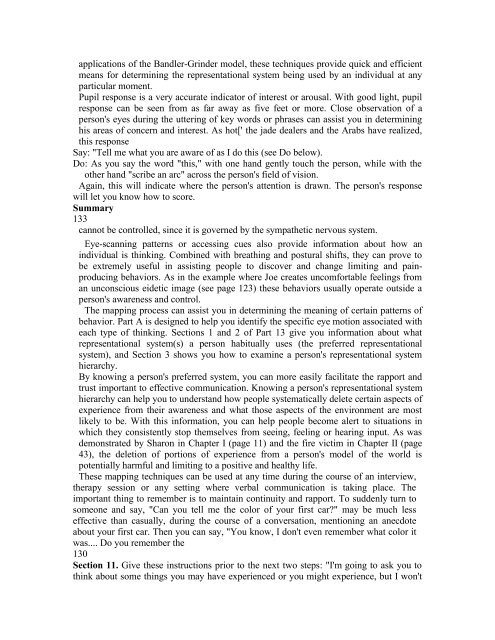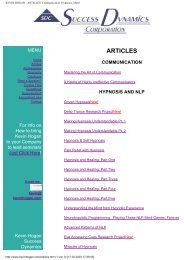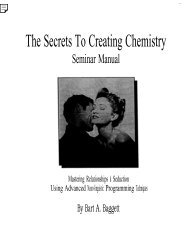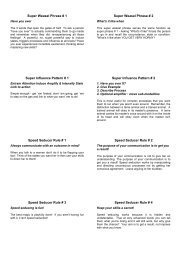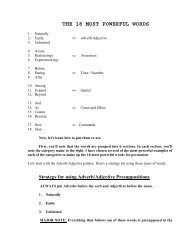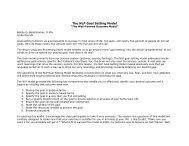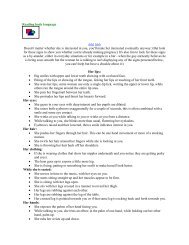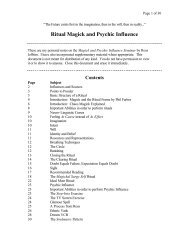A Pragmatic Guide To Communication & Change.pdf - NLP Info Centre
A Pragmatic Guide To Communication & Change.pdf - NLP Info Centre
A Pragmatic Guide To Communication & Change.pdf - NLP Info Centre
- No tags were found...
You also want an ePaper? Increase the reach of your titles
YUMPU automatically turns print PDFs into web optimized ePapers that Google loves.
applications of the Bandler-Grinder model, these techniques provide quick and efficient<br />
means for determining the representational system being used by an individual at any<br />
particular moment.<br />
Pupil response is a very accurate indicator of interest or arousal. With good light, pupil<br />
response can be seen from as far away as five feet or more. Close observation of a<br />
person's eyes during the uttering of key words or phrases can assist you in determining<br />
his areas of concern and interest. As hot[' the jade dealers and the Arabs have realized,<br />
this response<br />
Say: "Tell me what you are aware of as I do this (see Do below).<br />
Do: As you say the word "this," with one hand gently touch the person, while with the<br />
other hand "scribe an arc" across the person's field of vision.<br />
Again, this will indicate where the person's attention is drawn. The person's response<br />
will let you know how to score.<br />
Summary<br />
133<br />
cannot be controlled, since it is governed by the sympathetic nervous system.<br />
Eye-scanning patterns or accessing cues also provide information about how an<br />
individual is thinking. Combined with breathing and postural shifts, they can prove to<br />
be extremely useful in assisting people to discover and change limiting and painproducing<br />
behaviors. As in the example where Joe creates uncomfortable feelings from<br />
an unconscious eidetic image (see page 123) these behaviors usually operate outside a<br />
person's awareness and control.<br />
The mapping process can assist you in determining the meaning of certain patterns of<br />
behavior. Part A is designed to help you identify the specific eye motion associated with<br />
each type of thinking. Sections 1 and 2 of Part 13 give you information about what<br />
representational system(s) a person habitually uses (the preferred representational<br />
system), and Section 3 shows you how to examine a person's representational system<br />
hierarchy.<br />
By knowing a person's preferred system, you can more easily facilitate the rapport and<br />
trust important to effective communication. Knowing a person's representational system<br />
hierarchy can help you to understand how people systematically delete certain aspects of<br />
experience from their awareness and what those aspects of the environment are most<br />
likely to be. With this information, you can help people become alert to situations in<br />
which they consistently stop themselves from seeing, feeling or hearing input. As was<br />
demonstrated by Sharon in Chapter I (page 11) and the fire victim in Chapter II (page<br />
43), the deletion of portions of experience from a person's model of the world is<br />
potentially harmful and limiting to a positive and healthy life.<br />
These mapping techniques can be used at any time during the course of an interview,<br />
therapy session or any setting where verbal communication is taking place. The<br />
important thing to remember is to maintain continuity and rapport. <strong>To</strong> suddenly turn to<br />
someone and say, "Can you tell me the color of your first car?" may be much less<br />
effective than casually, during the course of a conversation, mentioning an anecdote<br />
about your first car. Then you can say, "You know, I don't even remember what color it<br />
was.... Do you remember the<br />
130<br />
Section 11. Give these instructions prior to the next two steps: "I'm going to ask you to<br />
think about some things you may have experienced or you might experience, but I won't


